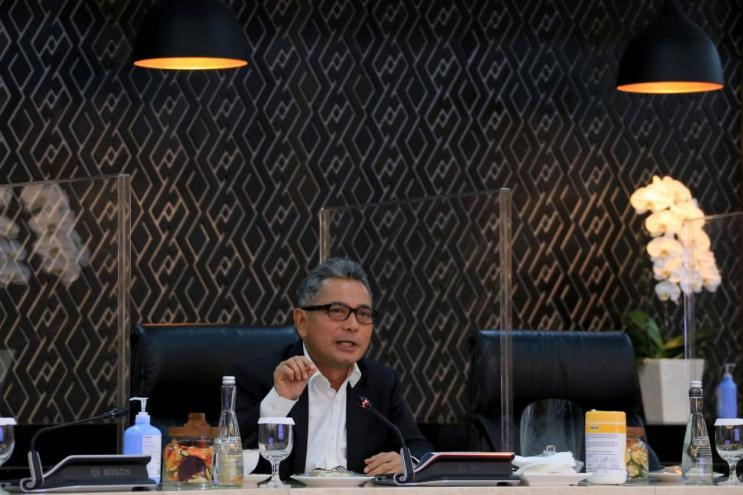Popular Reads
Top Results
Can't find what you're looking for?
View all search resultsPopular Reads
Top Results
Can't find what you're looking for?
View all search resultsBRI sees 43% contraction in Q3 profits, pins hope on MSMEs for recovery
BRI booked Rp 14.15 trillion (US$1 billion) in net profits as of September, a contraction of 42.9 percent year-on-year (yoy) as its net interest income shrank 7.5 percent yoy to Rp Rp 56.05 trillion
Change text size
Gift Premium Articles
to Anyone
S
tate-owned Bank Rakyat Indonesia (BRI) recorded a deep drop in its net profits as of September due to slowing loan growth and a deterioration in its asset quality, leading it to further pin its hopes on micro, small and medium enterprises (MSMEs) for this year’s recovery
The publicly listed company booked Rp 14.15 trillion (US$1 billion) in net profits as of September, a contraction of 42.9 percent year-on-year (yoy) as its net interest income shrank 7.5 percent yoy to Rp you 56.05 trillion, according to the bank’s presentation material.
Its loan disbursement only grew 4.86 percent yoy to Rp 934.35 trillion during the first nine months of the year compared to more than 11 percent in annual growth recorded in the same period last year.
At the same time, the bank increased its loan-loss provision allocation by 24.2 percent to Rp 19.4 trillion as its gross non-performing loan (NPL) ratio increased slightly to 3.12 percent from 3.1 percent in the first nine months of last year.
“The main supporters of BRI's loan growth are the micro and retail and medium segments,” BRI president director Sunarso said during a virtual briefing on Wednesday.
The COVID-19 pandemic has significantly affected the country’s banking industry as the economic slowdown has caused loan demand to dwindle, leaving banks' liquidity to balloon while profitability falls and bad debt soars.
As of Sept. 30, BRI had restructured loans worth up to Rp 193.7 trillion for 2.95 million borrowers. The bank’s president director said that so far most of the borrowers whose loans had been restructured managed to pay back their obligations after the restructuring period ended.
Meanwhile, the bank’s third-party funds grew by 18 percent yoy to Rp 1.13 quadrillion.
BRI’s loan growth during the first nine months of the year was notably higher than the Indonesian banking industry’s loan growth at 0.12 percent, data from the Financial Services Authority (OJK) show.
According to the bank’s data, its consolidated loans for the MSME segment expanded by 8.28 percent as of September against the same period last year, with the micro segment growing by 8.91 percent, the retail and medium segment by 9.93 percent and the consumer segment by 3.81 percent. On the other hand, loans for the corporate segment contracted by 7.33 percent yoy.
BRI expects its loan growth to reach 4 to 5 percent this year as MSMEs have started to recover, it said.
On Wednesday, along with BRI’s financial performance report, the bank released the BRI Micro and SME Index (BMSI), which is said to be the first leading indicator in Indonesia to measure MSMEs' business activities.
The BMSI consists of two subindexes, the Business Activity Index (IAB) and the Business Activity Expectation Index (IEAB). The former measures the current situation while the latter measures expectations for the upcoming three months. The Index is scheduled to be published every quarter.
“We conclude that Indonesia’s MSMEs are starting to show a turning point after being hit by the pandemic,” Sunarso said, inferring from data showcased by the index.
In the third quarter, the score stood at 84.2, an increase of 18.7 points from the score of 65.5 in the second quarter. The IEAB score for the fourth quarter, on the other hand, was 109.3, signaling optimism.
A score of 0 to 99 shows that negative perceptions dominate over positive perceptions, 100 is a neutral zone, while a score of 101 to 200 shows that positive perceptions outweigh the negative.
Indonesia’s small businesses account for more than 60 percent of GDP and employ a majority of the labor force. They are among the hardest hit the COVID-19 outbreak as the economy enters into recession following economic contractions recorded in the second and third quarter.
Mirae Asset Sekuritas Indonesia analyst Lee Young Jun forecast that the bank’s net profits would accumulate to Rp 18 trillion by the end of the year.
“While we maintain our top-line forecast, we adjust up our earnings forecast from Rp 14 trillion to Rp 18 trillion in 2020 as there won’t be any one-off deferred tax expenses in the second half of 2020,” the analyst wrote in a report published on Oct. 23.
The bank’s shares, traded on the Indonesia Stock Exchange (IDX) under the code BBRI, dropped 4.13 percent on Thursday after rallying by 3 percent on Wednesday. The stock has lost 10.23 percent of its value so far this year versus a 13.35 percent decline recorded by the overall Jakarta Composite Index (JCI).










